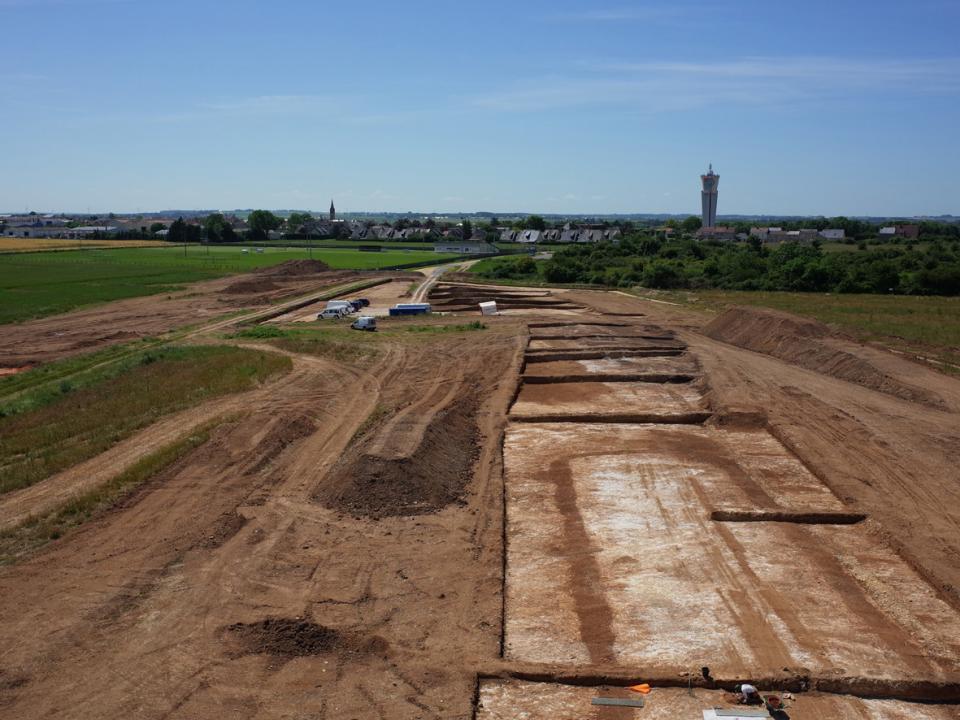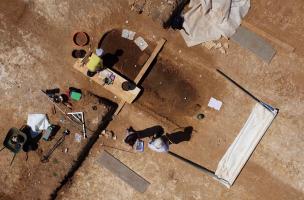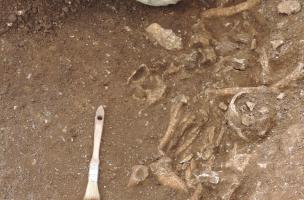Search
You are here
A Middle Neolithic necropolis in Fleury-sur-Orne
A team of Inrap archaeologists is currently excavating a 20 hectare site in Fleury-sur-Orne. This work, curated by the State (Drac Basse-Normandie) is taking place in advance of the construction of habitation zones by Normandie Aménagement and the Caen-La-Mer agglomeration.
Chronicle of site
Post date
10 September 2014
Last modified
08 January 2021
They have uncovered a large necropolis from the Middle Neolithic (4500 BC) containing around twenty funerary monuments, including one still intact burial mound.
6500 years ago, a monumental funerary architecture
During the Middle Neolithic, new types of funerary monuments appear: earth and wood constructions whose length varies from a few dozen to several hundreds of meters.
These monumental graves, the first of this type, are called “from Passy” after the eponymous site in the Yonne Department. These big, elongated monuments are delimited by trenches that are sometimes associated with a palisade. They surround a burial mound containing the tomb of prestigious persons. In contrast to earlier traditions, these funerary monuments suggest the emergence of a new social hierarchy.
In Fleury-sur-Orne, around twenty monumental tombs have been identified by the archaeologists. Their size and morphology is varied: from 12 m to 00 m long, surrounded by trenches from 20 cm to more than 15 m wide.
These monumental graves, the first of this type, are called “from Passy” after the eponymous site in the Yonne Department. These big, elongated monuments are delimited by trenches that are sometimes associated with a palisade. They surround a burial mound containing the tomb of prestigious persons. In contrast to earlier traditions, these funerary monuments suggest the emergence of a new social hierarchy.
In Fleury-sur-Orne, around twenty monumental tombs have been identified by the archaeologists. Their size and morphology is varied: from 12 m to 00 m long, surrounded by trenches from 20 cm to more than 15 m wide.

A still intact burial mound
Six thousand, five hundred years ago, these graves were covered by an earthen burial mound, a type of raised structure that has most often been levelled by modern agriculture. In Fleury, one of them was exceptionally preserved by an Antique road. Its construction method is very unusual, with “sod” walls built up from a few layers of grass slabs. A study of the collapses suggests that the mound, or tumulus, most have originally been more than 2 m high. Such tumuli were still visible on the Fleury landscape until the Second World War.
Under the mounds, the graves…
Each monument was designed to hold a few graves, or often a single individual. The most typical graves are very large – 3.5 to 4 m long – and contain an armed man. There was perhaps a bow, but certainly some arrows, of which only the arrowhead remains. Whole sheep were placed near the deceased as a viaticum. Contemporary with the large dolmens on the Atlantic coast, the monumental tombs of Fleury required considerable work and resources for the benefit of just a few, and thus reflect the emergence of social differentiation.
This excavation will soon be followed various analyses – paleogenetic, isotopic, parasitological – in order to learn more about the lineage of these human groups, as well as their diet and the illnesses they suffered.
This excavation will soon be followed various analyses – paleogenetic, isotopic, parasitological – in order to learn more about the lineage of these human groups, as well as their diet and the illnesses they suffered.

Reconstitution hypothétique de la plaine occupée par la nécropole
© Laurent Juhel / Inrap

Vue aérienne du site
© François Levalet / Inrap

Le monument 19, de 60 m de longueur, avec sa tombe monumentale d'archer accompagné de 7 moutons
© François Levalet / Inrap

Une sépulture d'archer de l'Âge du Bronze ancien réinstallée dans le monument 26
© François Levalet / Inrap

Bassin de l'archer inhumé dans le monument 26, avec une flèche tranchante fichée dans l'os
© P. Chambon, CNRS / Inrap
Developer : Normandie Aménagement and the Caen-la-Mer Agglomeration
Curation : Regional Archaeology Service (Drac Basse-Normandie)
Archaeological research : Inrap
Site directors : Emmanuel Ghesquière, Inrap and Philippe Chambon, CNRS
Contact(s) :
Mahaut Tyrrell
Media communication
Inrap, media partnerships and relations
01 40 08 80 24
mahaut.tyrrell [at] inrap.fr ( )
Mélanie Scellier
Cultural development and communication
Inrap, Grand-Ouest Interregional direction
06 71 04 59 92
melanie.scellier [at] inrap.fr ( )
Media communication
Inrap, media partnerships and relations
01 40 08 80 24
mahaut.tyrrell [at] inrap.fr ( )
Mélanie Scellier
Cultural development and communication
Inrap, Grand-Ouest Interregional direction
06 71 04 59 92
melanie.scellier [at] inrap.fr ( )





